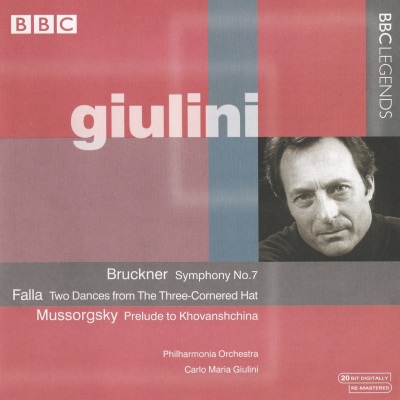
Bruckner: Symphony No. 7 / Falla: Two Dances from the Three-Cornered Hat / Mussorgsky: Prelude to Kh
EDUARD VAN BEINUM worked with the Philharmonia only six times, replacing the indisposed Klemperer in a Beethoven series in 1958. Obviously the chemistry worked, and he was able to turn the muscularity of Klemperer’s orchestra to his own ends. The first movement of the Second Symphony is sinewy rather than rugged, and the slow movement has some nicely pointed phrasing, but the sound still has weight. This tells even more in the larger landscape of the Seventh Symphony, with an introduction unfolding like a tightly coiled spring, and a vigorous scherzo and finale with a full range of dynamics. Which is also what you get in spades in a Ninth from KLAUS TENNSTEDT at a 1985 Prom. His instinct for the live event makes this an electrifying listen, with the LPO players clearly on the edge of their seats, not always keeping up with the hectic pace in the scherzo. But the slow movement has a warm inner light that recalls Furtwängler (though at a faster tempo) and the finale combines flexibility and an intensity that’s at times almost violent, carrying the work to an explosive conclusion and an ecstatic reception from the Proms audience – predictable, but thoroughly deserved. More Beethoven from an older tradition comes from DAVID OISTRAKH in the Royal Festival Hall in 1965. It’s not just the full orchestral sound behind him (though Kondrashin does handle it with considerable finesse) but the timbre of his violin: sweet and solid at the same time, with tonal intensity in every note. Sometimes – in the first entry in the slow movement – there’s just too much sound, but in the first movement he responds to the rapidly changing moods with sensitive modulations of colour. In the Mozart, though, his tone is too aggressive, and the orchestra too large – Classical lightness isn’t there, despite some elegant phrasing. CLAUDIO ARRAU’s 1963 Brahms doesn’t displace either of his studio recordings, with Giulini and Haitink. There may be a little more flexibility inherent in the live situation – the relaxed final movement is delightful – but the piano is rather metallic, and the acoustic of Glasgow’s Kelvin Hall on the boomy side: the solo cello in the slow movement sounds almost off-stage. It’s good to be reminded of the standard of the SNO under Gibson, though, as well as what a sensitive accompanist he was. The Schubert pieces from 1959 find Arrau with a better, if slightly distant piano sound, and playing with a freedom and affection that challenge his studio versions. Finally, the Philharmonia is on radiant form for CARLO MARIA GIULINI in a Bruckner symphony he’d only just added to his repertoire in 1982. There’s all the maturity of a great conductor at his peak, but also the excitement of discovery: a real urgency in the way the first movement pushes forwards in the first five minutes, and in the galloping rhythms of the scherzo. But perhaps it’s in the slow movement that Giulini’s at his best – beauty of sound and balanced chording don’t get in the way of the inevitable and natural forward flow of the music. One of the best issues in this series for some time. (classical-music.com)
